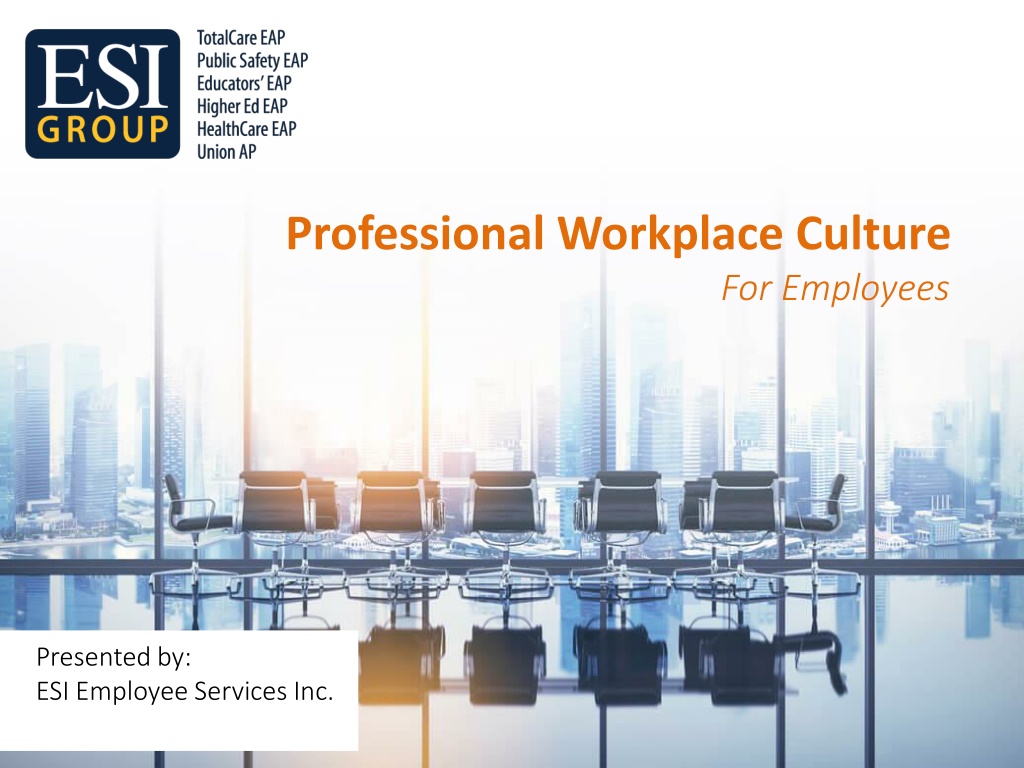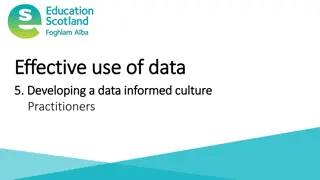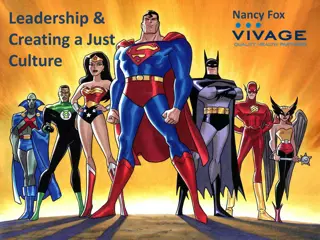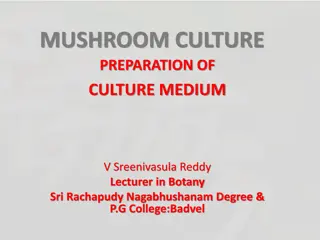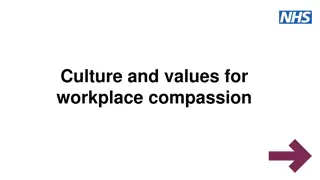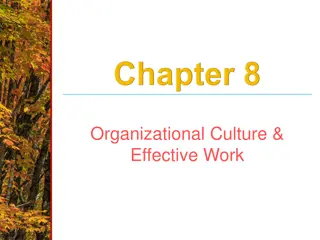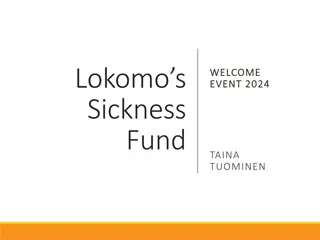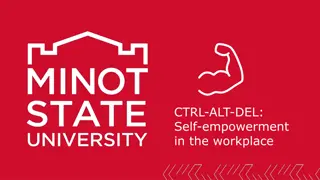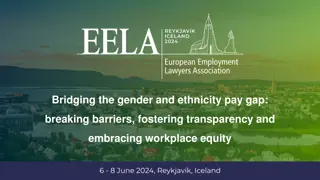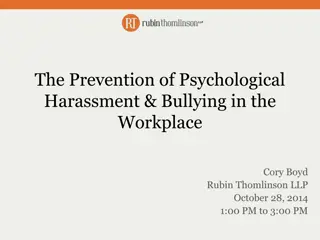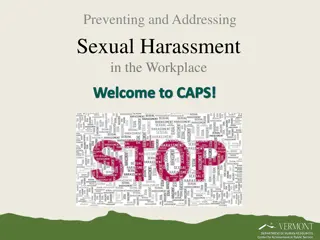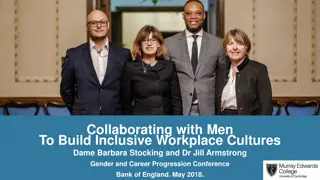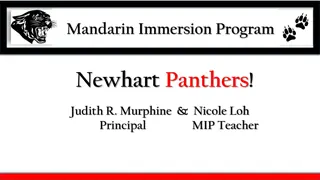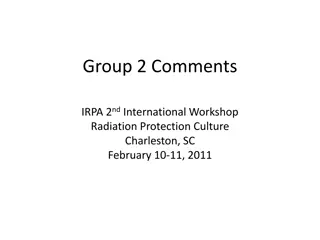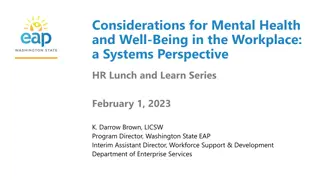Cultivating a Professional Workplace Culture: Key Aspects and Benefits
Establishing a professional workplace culture is essential for fostering healthy work relationships, boosting productivity, and enhancing employee well-being. It involves creating a sense of safety, reducing stress, promoting teamwork, and improving job satisfaction. Respect, effective communication, and addressing conflicts positively are vital elements. Barriers to a professional work environment may include job-related stress, interpersonal issues, task management challenges, personal problems, past experiences, and health issues.
Uploaded on Jul 31, 2024 | 0 Views
Download Presentation

Please find below an Image/Link to download the presentation.
The content on the website is provided AS IS for your information and personal use only. It may not be sold, licensed, or shared on other websites without obtaining consent from the author. Download presentation by click this link. If you encounter any issues during the download, it is possible that the publisher has removed the file from their server.
E N D
Presentation Transcript
Professional Workplace Culture For Employees Presented by: ESI Employee Services Inc.
Why is Creatinga Professional Workplace Culture Important?
A Professional Workplace Culture Includes: Healthy Work Relationships Increased Productivity A Sense of Safety and Well-being
Howis it helpful? Reduces stress Promotes better teamwork Enhances job satisfaction
Professionalvs.Unprofessional People enjoy working together Changes can be made with full cooperation Employees and managers are willing to help wherever needed Customers report high marks for service Problems and issues are discussed openly When something doesn t work, the focus is on identifying issues not blaming People form cliques and gossip Employees resist change or undermine it Employees and managers stick to it s not my job attitude Customers complain about service Problems aren t discussed even though everyone knows about them When something doesn t work, the focus is on blaming people or each other
Respect In a respectful,caring,and responsible work environment: Employees feel valued Communication is polite and courteous People treat each other as they want to be treated Conflict is addressed in a positive and respectful manner Harassment and disrespectful behavior are not tolerated
You may NOT like someone or choose them as a friend, but it is your responsibility to figure out how to have a courteous and professional work relationship. EVERYONE deserves to be treated respectfully at work.
What are the Barriers to a Professional Work Environment? Job-related stressors Issues with co-workers and/or supervisors Difficulty managing responsibilities or tasks Personal issues or problems Past experiences Health issues
Strategies for a Positive Work Environment Try to understand the other person s point of view Accept values and opinions that are different from your own (or agree to disagree) Identify your own feelings before you share your concerns with another person Do not blame, threaten, or name call even if you are angry or hurt Report harassment, discrimination, or abuse
No matter what your line of work, your degree of success depends on your ability to interact effectively with other people. From The 5 Essential People Skills by Dale Carnegie
Methods of Communication Sometimes it is not WHAT you say, but HOWyou say it.
Verbal Communication It involves words, tone, and pace.
Non-Verbal Communication Body language (arms crossed, sitting, relaxed, tense, etc ) Emotion of the sender and receiver (anxious, angry, upset, stressed, etc ) Similarities or differences between the people (friends, adversaries, age, profession, etc )
Communication The Process In any communication at least some of the meaning is lost The message that is heard is often far different than the one intended, due to a variety of factors.
Some Barriers of Effective Communication Misreading body language, tone, and other non-verbal forms of communication Selective hearing or distractions Defensiveness Assumptions Judgments (e.g., stereotyping) Cultural differences Stress
Barriers to Active Listening Mind Reading Interrupting Filtering Rehearsing
Effective Communication Maintain a positive and concerned attitude Be aware of your audience Use approachable language - Say: Lets see what we can do, instead of automatically saying, No
Effective Communication Be direct and specific Utilize assertive communication skills - Assumes that I have the right to express myself and be heard and so do you, even if we do not agree - Talk about actions not character - Take responsibility for your own thoughts and feelings - Use direct statements to express thoughts, feelings, and ideas
Words that Promote Conflict You must This is so typical of you You always / you never The problem is If you don t do this, then You ll never change You re being hysterical What is the matter with you?
The Iceberg of Conflict Issue Personality Emotions Interests, Needs and Desires Self-Perceptions and Self-Esteem Hidden Expectations Unresolved Issues from the Past
Additional Strategies Respect each other s boundaries Acknowledge and solve problems - Acknowledge the other person s needs - Listen patiently and repeat back what you think you heard - Use empathy - Ask questions that will provide you with information - Give each other the benefit of the doubt - Offer a choice of solutions
Additional Strategies Try to get along with difficult people Remember, difficult people often come into a situation with their own set of problems we may be unaware of Focus on the facts not on their emotions Try not to take it personally and focus on the whole person Listen patiently and let the person express him/herself Acknowledge the other person s feelings or pain Show that you really heard and understand by clarifying their words
Additional Strategies Balance family and work life Create a supportive network of co-workers and friends
Conclusion Aprofessional work culture is enhanced if employeescontinuallyuse effective strategies to activelylistento one another and work together to resolve differences in a healthy way.
The Leader in Productivity Solutions More benefits More programs More value than any other EAP
